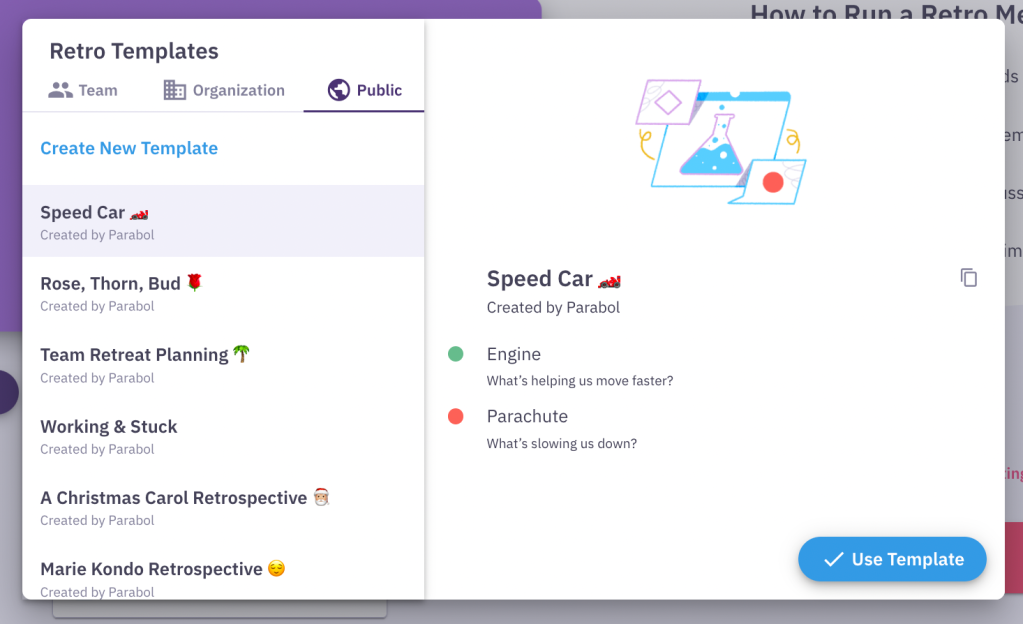Speed Car Retrospective
Start your engines with this lightning-fast retrospective template

What is a Speed Car retrospective?
Vroom vroom! What’s driving your team forward, and what’s slowing you down?
This is a lighting-fast, action-oriented retro for zeroing-in on ways to improve. By looking back, your team can get valuable data on how to work better, faster, and stronger moving forward.
With just two prompts, this is a lean agile retrospective template to whip out when you want to focus on improving your sprint velocity.
So raise that checkered flag, hop in your race car, and let’s get going!
🏎️ Engine
What’s propelling your scrum team forward? What processes, skills, and strategies are helping you get things done faster and more efficiently?
Another way to think about this prompt is like the fuel in your team’s tank. What do you excel at that’s helping you do great work?
Example: Our team communication was on point last week. I felt like I was never unsure about what we needed to do next, and it really helped me work quickly.
🪂 Parachute
What’s a real drag on your agile team? Is anything slowing you down, and holding back the speed and quality of your work?
These could be internal forces, or external ones that you have no control over.
Even if the thing slowing you down is out of your hands, you and your team members can use this retrospective activity to brainstorm ways of mitigating it.
Example: There were way too many ad-hoc meetings this week, and they didn’t feel very productive. I felt like I spent more time talking about project management, than actually completing the project.
When to do a Speed Car retrospective
As part of another meeting
If you want to bring a retrospective element to another, larger meeting, the Speed Car retrospective exercise could be just the ticket.
Because it’s so fast and efficient, you could use it to quickly recap before moving on to your next action items.
When things aren’t going as planned
If you hold regular retros, Speed Car could be the template that you’ve been looking for. Use it for a quick, results-oriented look back that can guide your process going forward.
It’s particularly helpful when there are many things slowing a team down.
It’s also ideal for ongoing team building, because you’re improving how you do things now while also looking forward to your next sprint.
When you want to improve sprint velocity
The Speed Car retrospective is all about helping your team remove blockers and work more efficiently. That’s why it’s perfect for teams that want to improve their sprint velocity.
Talk about how to double down on successful practices and remove persistent blockers.
How to run a Speed Car retrospective in Parabol
First of all, jump into Parabol. If you’re a Scrum Master or the team meeting facilitator hit the vibrant Add New Meeting button.
Select the Speed Car retrospective template
Jump into Parabol and select Retro Meeting with the arrows, then use the dropdown to select the Speed Car retrospective template. This is where you’ll find Parabol’s library of 40+ retrospective ideas.

Every Parabol retrospective begins with an optional icebreaker. This box is checked by default. You don’t have to do one, but we recommend it.
Start your Speed Car retro with an Icebreaker
If you’re doing an icebreaker, you’ll have a random question to answer. You can refresh it if you want another option, and of course you can create your own if you want.
Perhaps ask team members what their dream car is!

After the icebreaker you’ll move on to the reflect stage. This is where your team will do all their ideation and brainstorm in silence using the prompts above. All reflections are kept anonymous at this stage to prevent groupthink. Parabol gives you the option to timebox this process.
All Parabol sprint retrospectives can be run synchronously or asynchronously. Functionalities such as the timer, voting and multiplayer grouping help you make your retrospective exercise a success and make facilitation easier.
Reflect, Group, and Discuss topics based on the Speed Car retro prompts
Team members can all leave comments together, or do it at a time that works for them. Also, reflections are anonymous, and no one can see them until you’re done working on them.
After the reflect phase, you’ll vote on issues to discuss, talk about the most voted on items, and set action items for each process improvement so you can make it a reality.
Parabol will send a summary of the retro when you’re done so nobody needs to take notes.
Of course, you can do this retrospective in person, with a whiteboard or sticky notes. But it’s even easier in Parabol, especially if you’re an asynchronous or distributed team.
If you like this template, you might also like the starfish retrospective, energy levels retrospective, or working and stuck retrospective.